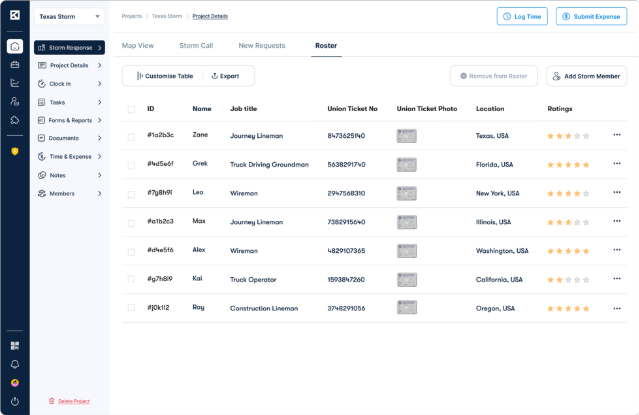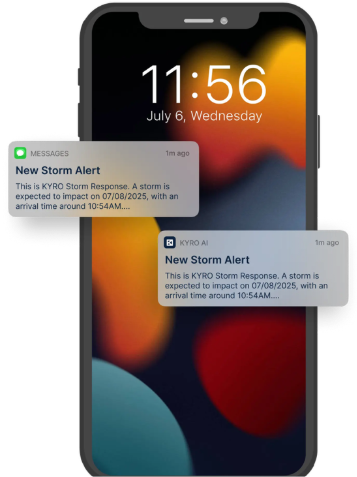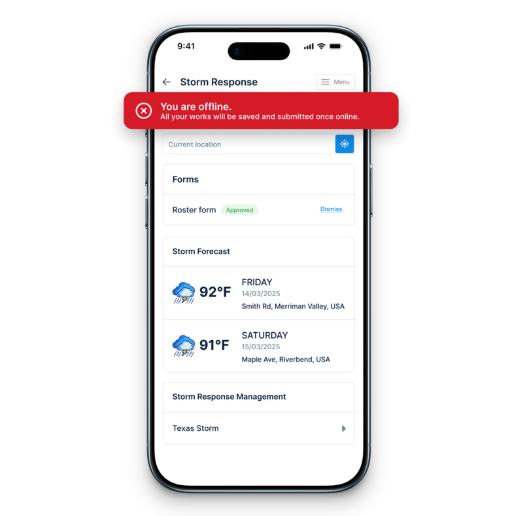
When storms strike, communication can make or break a utility’s response. Crews get scattered, conditions change by the minute, and dispatch teams struggle to keep everyone aligned.
Yet, many utilities still rely on fragmented systems such as emails, spreadsheets, and manual check-ins to manage hundreds of workers in the field. They prefer to operate in the dark with significant latency in data communication.
And the result? Missed messages. Delayed mobilization. Duplicate work. And crews go to the wrong places or sit idle while customers wait for the lights to come back on.
From delayed decision-making to preventable safety incidents, the impact of limited awareness and siloed information can ripple through every aspect of utility storm response operations.
In fact, communication breakdowns are one of the top three causes of storm recovery delays across U.S. utilities. But this doesn’t have to be the norm.
That’s where KYRO AI’s Storm Response platform steps in. Turning disjointed communication into a coordinated, real-time network.
When a storm hits, utilities must coordinate across hundreds of moving parts:
But most teams lack a shared communication hub. Updates are delayed or lost in inboxes. Contractors aren’t sure where to report, what to report, or when to do it. Dispatchers don’t know who’s available. This lack of real-time visibility slows restoration and increases costs.
Even when utilities use multiple digital tools, they often operate in silos, making it hard to see who’s working where, or whether tasks have been accepted, started, or completed.
KYRO AI’s Storm Response platform was built to eliminate these very barriers. It connects everyone, from command centers to field crews, through one intelligent communication and coordination layer.
Here’s how it works:
Assigning the right crew to the right job shouldn’t require a dozen phone calls or spreadsheets.

KYRO AI makes it effortless. The platform uses filters like crew skillsets, certifications, availability, and location to suggest the best match for each project. Dispatchers can assign jobs with a few clicks, and the crew receives instant SMS notifications.
As soon as they accept, the system logs the confirmation, updates the live roster, and automatically reflects it on GIS maps for real-time field tracking.
This reduces miscommunication, prevents double-booking, and ensures every crew member knows exactly where to go and what to do.
When storms hit, time is everything. KYRO AI helps contractors or utility companies send instant SMS alerts to crew members’ mobile phones. No app downloads are required.

These messages notify workers of new assignments, availability requests, or urgent updates. Crews can accept or decline work directly from their phone, and the system instantly reflects their response in the command dashboard.
This real-time feedback eliminates guesswork and reduces hours of manual check-ins. Dispatchers immediately know:
There’s no missed messages or communication gaps here. No waiting for call-backs. Just instant clarity across the workforce.
During storm events, utilities often bring in mutual aid or contract crews. But traditional onboarding, paper forms, email exchanges, and manual data entry create huge delays. Even the forms that’s in use take hours if not minutes for the crew members to update the details and submit them.
We wanted to simplify and cut short the time here too. So, we made sure we design forms that are super easy to fill in by the crew members and that which can be submitted in just a few minutes.

KYRO AI simplifies this entire process of onboarding with easy-to-fill digital forms designed for speed and clarity.
Most importantly, the forms are customizable based on the org’s needs.
This simplification and automation help utilities mobilize external crews in minutes, not hours, allowing faster field deployment when it matters most.
Knowing who’s actually accepted an assignment or who’s declined it. This gives clarity on the number of crew members you have ready for building the roster and helps communicate the same to utility companies and contractors. This is critical during storm recovery.
With KYRO AI, as soon as a crew member confirms availability via SMS or the KYRO AI storm response software, the dispatcher gets real-time visibility into their status.
This level of awareness and communication keeps every stakeholder, from field supervisors to mutual aid coordinators, on the same page.
Working under the trenches and dealing with poor networks? Even when connectivity drops, KYRO AI keeps the communication loop intact.

Crews can easily:
Once the signal is restored, data automatically syncs back to the command dashboard, ensuring no report or update is ever lost.
So how does this help storm damage restoration and other operations work?
With KYRO AI, utilities can transform their storm response operations from reactive chaos to coordinated precision.
Utilities using KYRO’s storm response system have seen measurable improvements in crew coordination and restoration efficiency, helping them restore power faster while maintaining safety and compliance standards.
When storms disrupt infrastructure, the real challenge isn’t just damage. It’s a disconnection and a gap in communication. Crews in the field, offices at HQ, and mutual aid partners all need to act as one team, and they need to remain on the same page, always.
KYRO AI’s Storm Response bridges that gap with a unified communication system powered by real-time alerts, smart onboarding, and automated project assignments.
Because in storm response, every minute, and every message counts!
Don’t let communication gaps slow down your next storm response! See how KYRO AI connects your field and office teams in real time.
Request a KYRO Storm Response demo
When storms strike, communication can make or break a utility’s response. Crews get scattered, conditions change by the minute, and dispatch teams struggle to keep everyone aligned.
Yet, many utilities still rely on fragmented systems such as emails, spreadsheets, and manual check-ins to manage hundreds of workers in the field. They prefer to operate in the dark with significant latency in data communication.
And the result? Missed messages. Delayed mobilization. Duplicate work. And crews go to the wrong places or sit idle while customers wait for the lights to come back on.
From delayed decision-making to preventable safety incidents, the impact of limited awareness and siloed information can ripple through every aspect of utility storm response operations.
In fact, communication breakdowns are one of the top three causes of storm recovery delays across U.S. utilities. But this doesn’t have to be the norm.
That’s where KYRO AI’s Storm Response platform steps in. Turning disjointed communication into a coordinated, real-time network.
When a storm hits, utilities must coordinate across hundreds of moving parts:
But most teams lack a shared communication hub. Updates are delayed or lost in inboxes. Contractors aren’t sure where to report, what to report, or when to do it. Dispatchers don’t know who’s available. This lack of real-time visibility slows restoration and increases costs.
Even when utilities use multiple digital tools, they often operate in silos, making it hard to see who’s working where, or whether tasks have been accepted, started, or completed.
KYRO AI’s Storm Response platform was built to eliminate these very barriers. It connects everyone, from command centers to field crews, through one intelligent communication and coordination layer.
Here’s how it works:
Assigning the right crew to the right job shouldn’t require a dozen phone calls or spreadsheets.

KYRO AI makes it effortless. The platform uses filters like crew skillsets, certifications, availability, and location to suggest the best match for each project. Dispatchers can assign jobs with a few clicks, and the crew receives instant SMS notifications.
As soon as they accept, the system logs the confirmation, updates the live roster, and automatically reflects it on GIS maps for real-time field tracking.
This reduces miscommunication, prevents double-booking, and ensures every crew member knows exactly where to go and what to do.
When storms hit, time is everything. KYRO AI helps contractors or utility companies send instant SMS alerts to crew members’ mobile phones. No app downloads are required.

These messages notify workers of new assignments, availability requests, or urgent updates. Crews can accept or decline work directly from their phone, and the system instantly reflects their response in the command dashboard.
This real-time feedback eliminates guesswork and reduces hours of manual check-ins. Dispatchers immediately know:
There’s no missed messages or communication gaps here. No waiting for call-backs. Just instant clarity across the workforce.
During storm events, utilities often bring in mutual aid or contract crews. But traditional onboarding, paper forms, email exchanges, and manual data entry create huge delays. Even the forms that’s in use take hours if not minutes for the crew members to update the details and submit them.
We wanted to simplify and cut short the time here too. So, we made sure we design forms that are super easy to fill in by the crew members and that which can be submitted in just a few minutes.

KYRO AI simplifies this entire process of onboarding with easy-to-fill digital forms designed for speed and clarity.
Most importantly, the forms are customizable based on the org’s needs.
This simplification and automation help utilities mobilize external crews in minutes, not hours, allowing faster field deployment when it matters most.
Knowing who’s actually accepted an assignment or who’s declined it. This gives clarity on the number of crew members you have ready for building the roster and helps communicate the same to utility companies and contractors. This is critical during storm recovery.
With KYRO AI, as soon as a crew member confirms availability via SMS or the KYRO AI storm response software, the dispatcher gets real-time visibility into their status.
This level of awareness and communication keeps every stakeholder, from field supervisors to mutual aid coordinators, on the same page.
Working under the trenches and dealing with poor networks? Even when connectivity drops, KYRO AI keeps the communication loop intact.

Crews can easily:
Once the signal is restored, data automatically syncs back to the command dashboard, ensuring no report or update is ever lost.
So how does this help storm damage restoration and other operations work?
With KYRO AI, utilities can transform their storm response operations from reactive chaos to coordinated precision.
Utilities using KYRO’s storm response system have seen measurable improvements in crew coordination and restoration efficiency, helping them restore power faster while maintaining safety and compliance standards.
When storms disrupt infrastructure, the real challenge isn’t just damage. It’s a disconnection and a gap in communication. Crews in the field, offices at HQ, and mutual aid partners all need to act as one team, and they need to remain on the same page, always.
KYRO AI’s Storm Response bridges that gap with a unified communication system powered by real-time alerts, smart onboarding, and automated project assignments.
Because in storm response, every minute, and every message counts!
Don’t let communication gaps slow down your next storm response! See how KYRO AI connects your field and office teams in real time.
Request a KYRO Storm Response demo